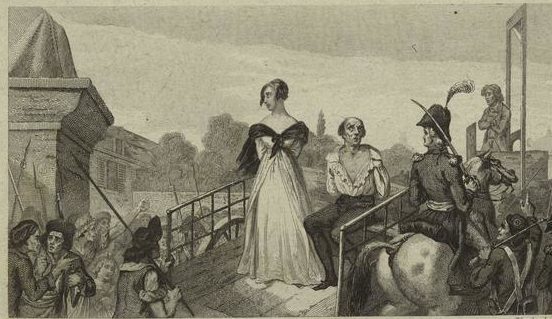The Reign of Terror was exactly as it sounds – terrifying. Whilst the French Revolution in 1789 was generally fairly violent, the part of it which was the Reign of Terror was horrifyingly so. If you were of the aristocracy, if you were of the pre-Revolution parliament, a collector of taxes, or basically anyone who even looked sideways at the revolution’s leaders, you were definitely having to watch your head.

Louis XVI
King Louis XVI is probably the most famous person to have met his fate by guillotine during this time (and for all time), though he was executed just prior to the Terror. Unlucky enough to be the reigning monarch during the revolution, and largely a part of its success due to his inability to comprehend what was really happening to his country, he was found guilty of treason in 1793 and sentenced to death. One can only imagine him saying goodbye to his family, the increasing sense of fear during the hour long carriage ride from the prison to the guillotine, with Parisians and troops armed with pikes and muskets lining the streets on 21 January 1793.
Henry Essex Edgeworth, an English priest who accompanied Louis XVI to the scaffold, wrote in his memoirs that the King “suddenly let go my arm, and I saw him cross with a firm foot the breadth of the whole scaffold; silence, by his look alone, fifteen or twenty drums that were placed opposite to me; and in a voice so loud, that it must have been heard it the Pont Tournant, I heard him pronounce distinctly these memorable words:
‘I die innocent of all the crimes laid to my charge; I Pardon those who have occasioned my death; and I pray to God that the blood you are going to shed may never be visited on France.’

Beheadings of nobles was nothing new. Kings and queens and traitors had long been executed by decapitation, but for thousands of years the method of using a sword was fairly barbaric, often very painful and usually messy. The invention of the guillotine was not made by Dr Joseph-Ignace Guillotin, even though it bears his name, but in 1789 he advocated for its use because he believed all people, not just the nobles, should have the right to be beheaded in case of a death sentence, and that such beheading should be made as painless as possible. In one of history’s small ironies, Dr Guillotin and chief executioner Charles Henri Sanson were called to the Tuilleries in Paris to meet with Louis XVI as he was interested in the plans for the new guillotine. When Louis XVI proposed a flat blade as opposed to a curved blade for greater efficiency, he may or may not have had any idea that the same blade would in a few years be used on his own neck, by the same executioner.

Marie Antoinette
Marie Antoinette, wife of Louis XVI, faced the same tragic ending. She may have had some idea of her fate; not only did the revolutionary authorities send her to prison in August 1793, they also thoughtfully presented her eight year old son, Louis, with a toy guillotine. Found guilty of treason after a speedy trial; Marie Antoinette’s death sentence was carried out the following morning on 16 October 1793. By all witness accounts she was dignified and graceful on the cart which carried her to the Place de la Révolution, where a large crowd jostling for position in front of the scaffold were awaiting. As she climbed the steps of the scaffold, she accidentally trod on the foot of the executioner and ever so politely said:
“Monsieur, je vous demande pardon, je ne l’ai pas fait exprès” (Sir, excuse me, I did not mean to do it)
However, in the memoirs of the executioner, Charles Henri Sanson, he claims the Queen “mounted the scaffold as majestically as if the steps of the guillotine had been those of the grand staircase at Versailles”, and credits her last words as:
Farewell, my children; I am going to join your father.

Whilst there was much bloodiness from the onset of the French Revolution in 1789, it was from 1793 to 1794 that affairs were really quite ugly in France. This became known as the Reign of Terror. There was an increasingly dictatorial government whose surveillance committees were everywhere searching for traitors. Thousands of citizens were arrested and hundreds of others were tried before “Revolutionary Tribunals” without appeal, and were executed.
The Parisians soon learned to look away or turn their backs to the endless number of cattle carts piled high with recently decapitated bodies during the Reign of Terror. At the Seine river bodies and heads were carelessly thrown in to make their way to the sea. Only a few hours before, those same victims had made their way in the same carts to the guillotine.

Olympe de Gouges
Despite the use of female figures as symbols of the new Republic, gender equality was far from the minds of the leaders of the Revolution. Olympe de Gouges, a feminist who penned the famous Declaration of the Rights of Women in hope that women would be granted equal rights, was to suffer the fall of the guillotine on 4 November 1793. Her last words as she faced the crowd were:
“Enfants de la Patrie, vous vengerez ma mort!” (Children of the homeland, avenge my death!)

Read my article on Olympe de Gouges here
Madame Roland
Less than a week later, popular society figure Marie-Jeanne Roland was to find herself at the guillotine. A supporter of revolutionary ideals, she had opened a salon in Paris where factions of the revolution met for aperitifs and dinners amidst the swirling cigar smoke, to discuss the future of the Republic of France. As any discussion of this kind was forbidden under the repressive regime of the Committee of Public Safety, Madame Roland was found guilty of treason. On her way to the guillotine she walked past a statue of liberty erected nearby and said the famous words:
‘O Liberté, que de crimes on commet en ton nom! (Oh liberty, what crimes are committed in your name!)

Adam Lux, willing participant..
It is difficult to imagine anyone actually wanting to go to the guillotine. Adam Lux, a German, apparently became so entranced after viewing the execution of Charlotte Corday (she murdered the bloodthirsty revolutionary leader Jean-Paul Marat) that he began to protest publicly against the revolution and its leaders in the hope he would enjoy the same end to his life. No surprise, he was sentenced to death by guillotine in November 1793. When he appeared on the scaffold, he willingly stretched himself out on the plank, exclaiming:
At last!
The guillotine continued to be used in France until 1977, until capital punishment was outlawed in 1981.
further reading
Timothy Tackett, The Coming of the Terror in the French Revolution, Belknap Press, 2015
John Julius Norwich, A History of France, Atlantic Monthly Press, 2018
Charles Henri Sanson , Mémoires des Sanson (Memoirs of the Sansons), 1830. Though based on facts, much has been fictionalised.




What a dark and violent period in France’s history and to think the guillotine was last used in 1977 out lawed in 1981 it makes you shudder! Poor Louis XV1, imagine recommending a particular sword only for it to be used on yourself a few years later. Thanks for the history lesson on the guillotine, I might have nightmares tonight!!!!!
I hope you don’t have nightmares! The French Revolution certainly had some tragic and terrifying moments.